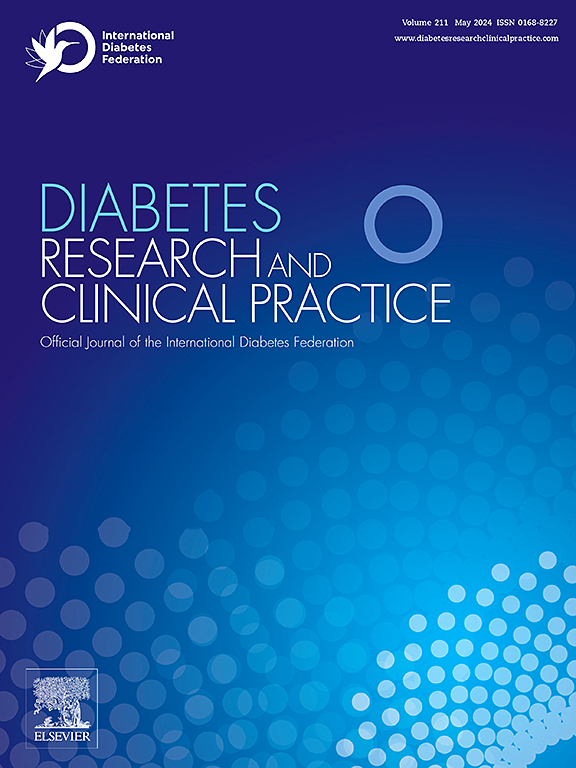The necessity of strengthening glycemic and lipid metabolism management for improving brain structure and cognitive function in people with diabetes: A retrospective study based on UK Biobank
IF 6.1
3区 医学
Q1 ENDOCRINOLOGY & METABOLISM
引用次数: 0
Abstract
Objective
To investigate the relation of glycemic and lipid metabolism with brain structure and cognitive function in people with diabetes, so as to improve cognitive function in these individuals.
Methods
Based on the UK Biobank, 26,394 patients, who were diagnosed with diabetes by doctors between 2006 and 2010, were included in the study. The demographic information, clinical data of glycemic and lipid metabolism and cognitive function (brain MRI and cognitive function scores) were collected. Multiple linear regression and non-restricted cubic spline analyses were used to investigate the relations of glycemic and lipid metabolism with brain structure and cognitive function.
Results
In this study, the mean age of people with diabetes (containing 39 % females) was 59.58 ± 7.21 years. Higher random blood glucose (β = −0.116, p < 0.001) and glycosylated hemoglobin (HbA1c) (β = −0.062, p = 0.051) were associated with a smaller brain volume. Higher HbA1c (β = 0.036, p < 0.001; β = 0.023, p = 0.021) was related with worse cognitive function. Further analysis showed that HbA1c < 6.5 % had a protective effect on cognitive function, and HbA1c = 6.5 %∼8.5 % and >8.5 % was unrelated and negatively related with cognitive function, respectively. Different types of lipids had varying effects on cognitive function. Higher total cholesterol (TC) (β = 0.125, p = 0.008), low density lipoprotein-cholesterol (LDL-C) (β = 0.086, p = 0.025), and ApoB (β = 0.092, p = 0.026) were associated with more significant brain structural abnormalities. Conversely, triglyceride (TG) = 0.75∼8.0 mmol/L was positively correlated with cognitive function (β = −0.036, p < 0.001; β = −0.044, p < 0.001; β = 0.058, p = 0.001), and higher ApoA (β = −0.032, p < 0.001; β = −0.033, p < 0.001; β = 0.047, p = 0.004) was associated with better cognitive function. The age-stratified analysis revealed that the impact of lipids on cognitive function was age-dependent. TC and LDL-C were related to brain structural abnormalities in the 55–60 age group, while TG had a stronger protective effect on cognitive function in older adults, particularly those aged 65–70 years.
Conclusion
In people with diabetes, higher HbA1c (>8.5 %), as well as elevated TC, LDL-C, and ApoB, are associated with worse brain structure and cognitive function. Conversely, HbA1c < 6.5 % and elevated TG within the range of 0.75∼8.0 mmol/L have a protective effect on cognitive function, and the later exhibited more evident impact in older adults. To prevent or delay the onset of dementia in people with diabetes, it may be necessary to intensify glycemic control, targeting an HbA1c level of <6.5 %. Additionally, the age-specific lipid-lowering strategies shall be considered, with more flexible triglyceride-lowering goals for elderly patients.
加强糖脂代谢管理对改善糖尿病患者脑结构和认知功能的必要性:基于UK Biobank的回顾性研究
目的:探讨糖尿病患者的糖脂代谢与脑结构及认知功能的关系,以期改善糖尿病患者的认知功能。方法:基于英国生物银行,26394名2006年至2010年间被医生诊断为糖尿病的患者被纳入研究。收集患者的人口学信息、血糖、脂质代谢和认知功能的临床数据(脑MRI和认知功能评分)。采用多元线性回归和非限制性三次样条分析探讨糖脂代谢与脑结构和认知功能的关系。结果:在本研究中,糖尿病患者的平均年龄为59.58 ± 7.21 岁(女性39% %)。随机血糖升高(β = -0.116,p 8.5 %)与认知功能无关,与认知功能负相关。不同类型的脂质对认知功能有不同的影响。高总胆固醇(TC)(β = 0.125,p = 0.008),低密度脂蛋白胆固醇(低密度脂蛋白)(β = 0.086,p = 0.025),和飞机观测(β = 0.092,p = 0.026)与更重要的脑结构异常有关。相反,甘油三酯(TG) = 0.75 ~ 8.0 mmol/L与认知功能呈正相关(β = -0.036,p 8.5 %),TC、LDL-C和ApoB升高与大脑结构和认知功能恶化相关。相反,糖化血红蛋白
本文章由计算机程序翻译,如有差异,请以英文原文为准。
求助全文
约1分钟内获得全文
求助全文
来源期刊

Diabetes research and clinical practice
医学-内分泌学与代谢
CiteScore
10.30
自引率
3.90%
发文量
862
审稿时长
32 days
期刊介绍:
Diabetes Research and Clinical Practice is an international journal for health-care providers and clinically oriented researchers that publishes high-quality original research articles and expert reviews in diabetes and related areas. The role of the journal is to provide a venue for dissemination of knowledge and discussion of topics related to diabetes clinical research and patient care. Topics of focus include translational science, genetics, immunology, nutrition, psychosocial research, epidemiology, prevention, socio-economic research, complications, new treatments, technologies and therapy.
 求助内容:
求助内容: 应助结果提醒方式:
应助结果提醒方式:


